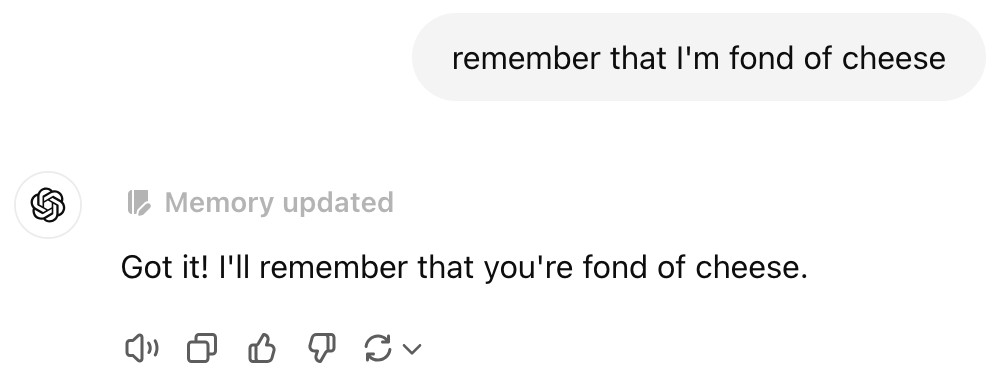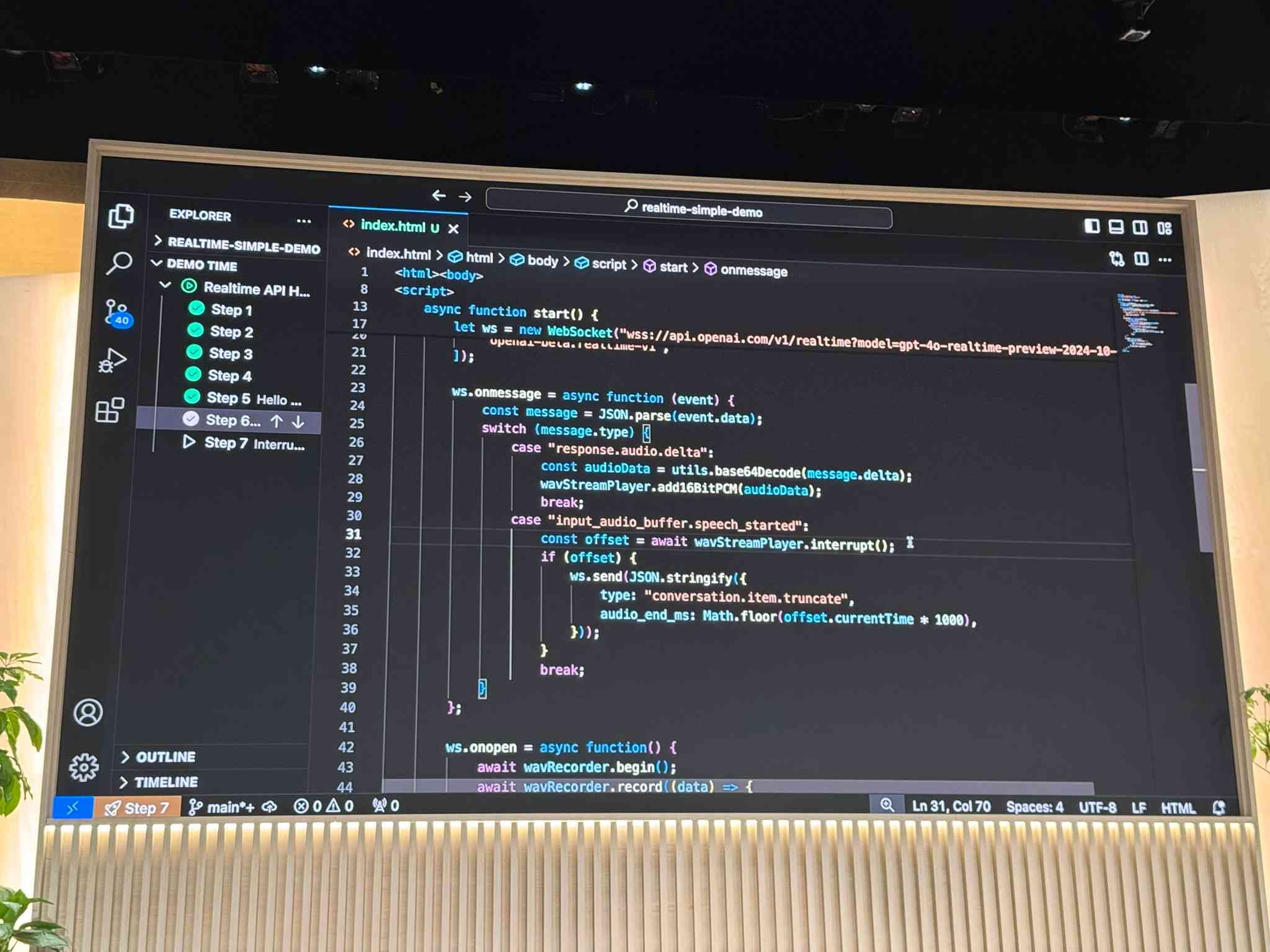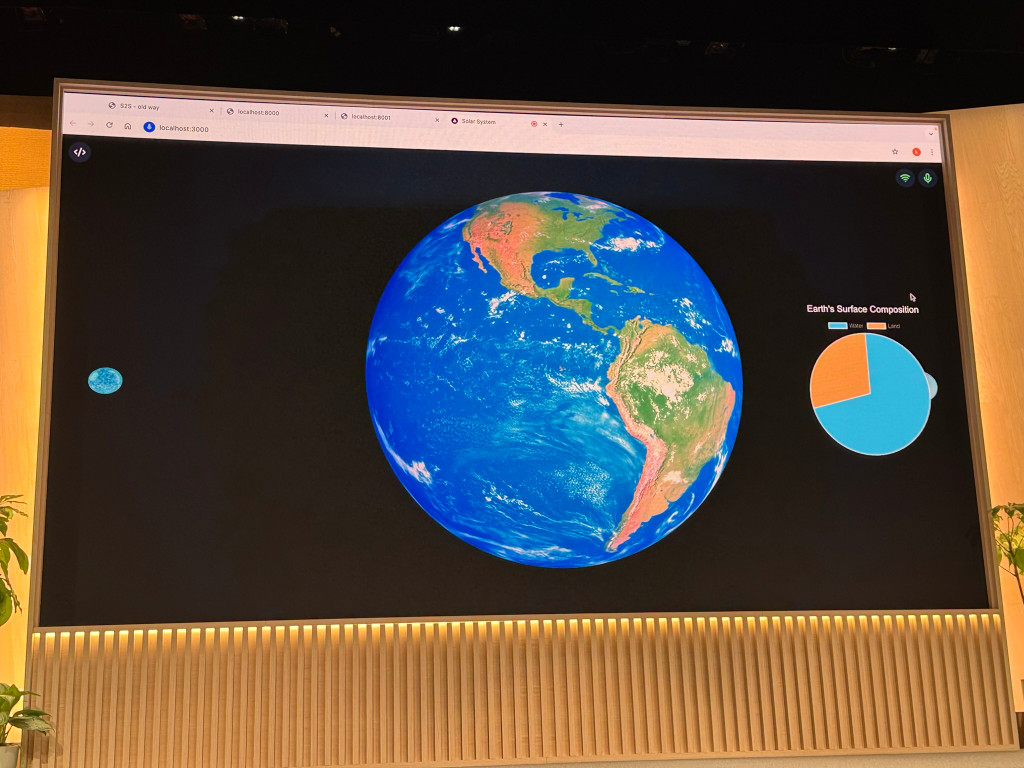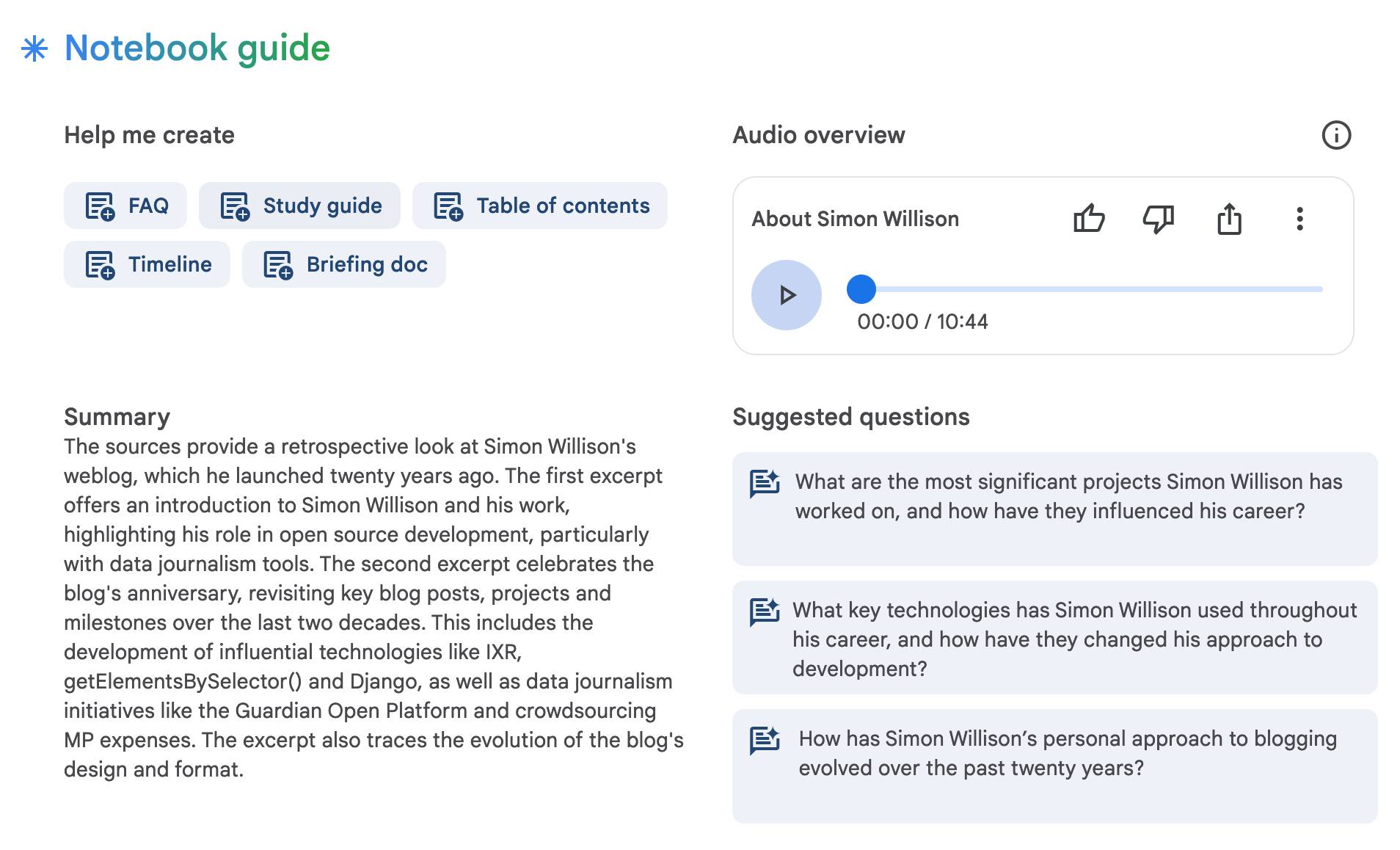1,740 posts tagged “ai”
"AI is whatever hasn't been done yet"—Larry Tesler
2024
ChatGPT will happily write you a thinly disguised horoscope
There’s a meme floating around at the moment where you ask ChatGPT the following and it appears to offer deep insight into your personality:
[... 1,236 words]My Jina Reader tool. I wanted to feed the Cloudflare Durable Objects SQLite documentation into Claude, but I was on my iPhone so copying and pasting was inconvenient. Jina offer a Reader API which can turn any URL into LLM-friendly Markdown and it turns out it supports CORS, so I got Claude to build me this tool (second iteration, third iteration, final source code).
Paste in a URL to get the Jina Markdown version, along with an all important "Copy to clipboard" button.
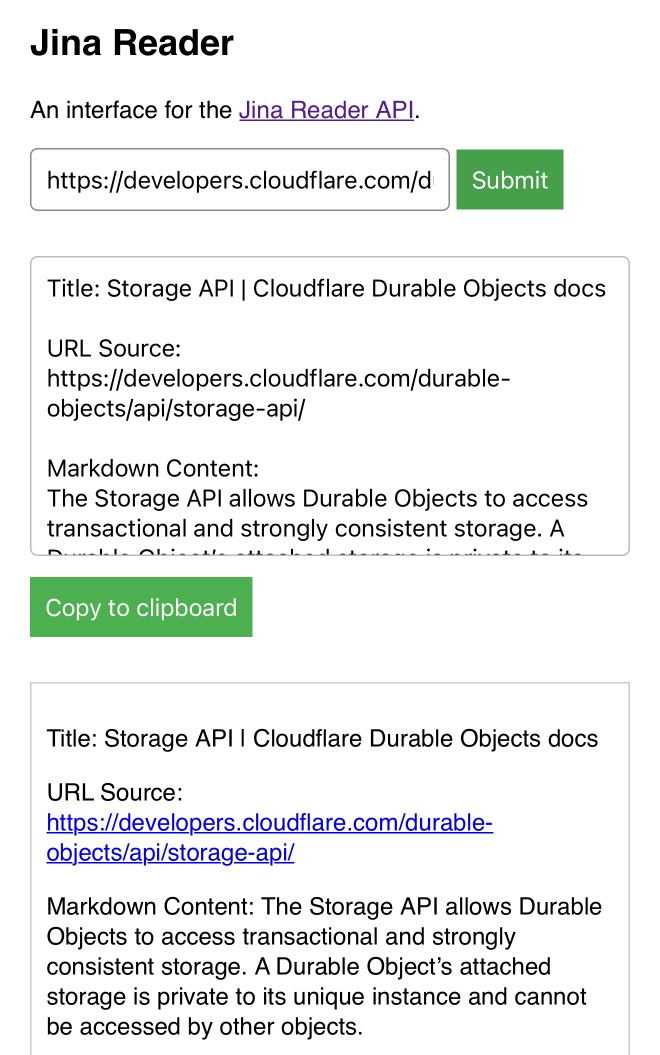
An LLM TDD loop (via) Super neat demo by David Winterbottom, who wrapped my LLM and files-to-prompt tools in a short Bash script that can be fed a file full of Python unit tests and an empty implementation file and will then iterate on that file in a loop until the tests pass.
Carl Hewitt recently remarked that the question what is an agent? is embarrassing for the agent-based computing community in just the same way that the question what is intelligence? is embarrassing for the mainstream AI community. The problem is that although the term is widely used, by many people working in closely related areas, it defies attempts to produce a single universally accepted definition. This need not necessarily be a problem: after all, if many people are successfully developing interesting and useful applications, then it hardly matters that they do not agree on potentially trivial terminological details. However, there is also the danger that unless the issue is discussed, 'agent' might become a 'noise' term, subject to both abuse and misuse, to the potential confusion of the research community.
— Michael Wooldridge, in 1994, Intelligent Agents: Theory and Practice
Frankenstein is a terrific book partly based on how concerned people were about electricity. It captures our fears about the nature of being human but didn’t help anyone really come up with better policies for dealing with electricity. I worry that a lot of AI critics are doing the same thing.
lm.rs: run inference on Language Models locally on the CPU with Rust (via) Impressive new LLM inference implementation in Rust by Samuel Vitorino. I tried it just now on an M2 Mac with 64GB of RAM and got very snappy performance for this Q8 Llama 3.2 1B, with Activity Monitor reporting 980% CPU usage over 13 threads.
Here's how I compiled the library and ran the model:
cd /tmp
git clone https://github.com/samuel-vitorino/lm.rs
cd lm.rs
RUSTFLAGS="-C target-cpu=native" cargo build --release --bin chat
curl -LO 'https://huggingface.co/samuel-vitorino/Llama-3.2-1B-Instruct-Q8_0-LMRS/resolve/main/tokenizer.bin?download=true'
curl -LO 'https://huggingface.co/samuel-vitorino/Llama-3.2-1B-Instruct-Q8_0-LMRS/resolve/main/llama3.2-1b-it-q80.lmrs?download=true'
./target/release/chat --model llama3.2-1b-it-q80.lmrs --show-metrics
That --show-metrics option added this at the end of a response:
Speed: 26.41 tok/s
It looks like the performance is helped by two key dependencies: wide, which provides data types optimized for SIMD operations and rayon for running parallel iterators across multiple cores (used for matrix multiplication).
(I used LLM and files-to-prompt to help figure this out.)
$2 H100s: How the GPU Bubble Burst. Fascinating analysis from Eugene Cheah, founder of LLM hosting provider Featherless, discussing GPU economics over the past 12 months.
TLDR: Don’t buy H100s. The market has flipped from shortage ($8/hr) to oversupplied ($2/hr), because of reserved compute resales, open model finetuning, and decline in new foundation model co’s. Rent instead.
Bridging Language Gaps in Multilingual Embeddings via Contrastive Learning (via) Most text embeddings models suffer from a "language gap", where phrases in different languages with the same semantic meaning end up with embedding vectors that aren't clustered together.
Jina claim their new jina-embeddings-v3 (CC BY-NC 4.0, which means you need to license it for commercial use if you're not using their API) is much better on this front, thanks to a training technique called "contrastive learning".
There are 30 languages represented in our contrastive learning dataset, but 97% of pairs and triplets are in just one language, with only 3% involving cross-language pairs or triplets. But this 3% is enough to produce a dramatic result: Embeddings show very little language clustering and semantically similar texts produce close embeddings regardless of their language
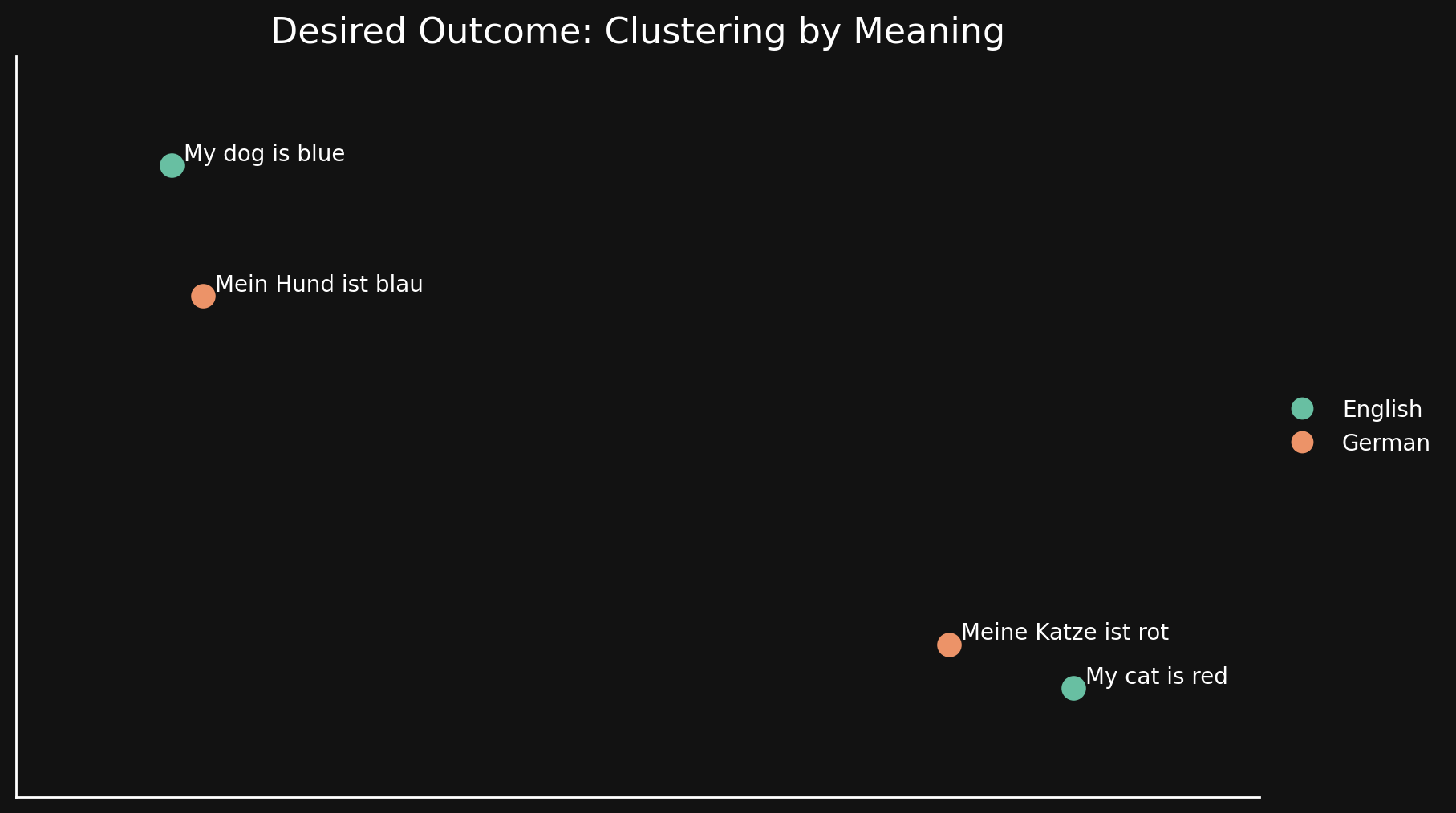
RISD BFA Industrial Design: AI Software Design Studio. Fascinating syllabus for a course on digital product design taught at the Rhode Island School of Design by Kelin Carolyn Zhang.
Designers must adapt and shape the frontier of AI-driven computing — while navigating the opportunities, risks, and ethical responsibilities of working with this new technology.
In this new world, creation is cheap, craft is automatable, and everyone is a beginner. The ultimate differentiator will be the creator’s perspective, taste, and judgment. The software design education for our current moment must prioritize this above all else.
By course's end, students will have hands-on experience with an end-to-end digital product design process, culminating in a physical or digital product that takes advantage of the unique properties of generative AI models. Prior coding experience is not required, but students will learn using AI coding assistants like ChatGPT and Claude.
From Kelin's Twitter thread about the course so far:
these are juniors in industrial design. about half of them don't have past experience even designing software or using figma [...]
to me, they're doing great because they're moving super quickly
what my 4th yr interaction design students in 2019 could make in half a semester, these 3rd year industrial design students are doing in a few days with no past experience [...]
they very quickly realized the limits of LLM code in week 1, especially in styling & creating unconventional behavior
AI can help them make a functional prototype with js in minutes, but it doesn't look good
openai/openai-realtime-console. I got this OpenAI demo repository working today - it's an extremely easy way to get started playing around with the new Realtime voice API they announced at DevDay last week:
cd /tmp
git clone https://github.com/openai/openai-realtime-console
cd openai-realtime-console
npm i
npm start
That starts a localhost:3000 server running the demo React application. It asks for an API key, you paste one in and you can start talking to the web page.
The demo handles voice input, voice output and basic tool support - it has a tool that can show you the weather anywhere in the world, including panning a map to that location. I tried adding a show_map() tool so I could pan to a location just by saying "Show me a map of the capital of Morocco" - all it took was editing the src/pages/ConsolePage.tsx file and hitting save, then refreshing the page in my browser to pick up the new function.
Be warned, it can be quite expensive to play around with. I was testing the application intermittently for only about 15 minutes and racked up $3.87 in API charges.
Anthropic: Message Batches (beta) (via) Anthropic now have a batch mode, allowing you to send prompts to Claude in batches which will be processed within 24 hours (though probably much faster than that) and come at a 50% price discount.
This matches the batch models offered by OpenAI and by Google Gemini, both of which also provide a 50% discount.
Update 15th October 2024: Alex Albert confirms that Anthropic batching and prompt caching can be combined:
Don't know if folks have realized yet that you can get close to a 95% discount on Claude 3.5 Sonnet tokens when you combine prompt caching with the new Batches API
SVG to JPG/PNG. The latest in my ongoing series of interactive HTML and JavaScript tools written almost entirely by LLMs. This one lets you paste in (or open-from-file, or drag-onto-page) some SVG and then use that to render a JPEG or PNG image of your desired width.

I built this using Claude 3.5 Sonnet, initially as an Artifact and later in a code editor since some of the features (loading an example image and downloading the result) cannot run in the sandboxed iframe Artifact environment.
Here's the full transcript of the Claude conversation I used to build the tool, plus a few commits I later made by hand to further customize it.
The code itself is mostly quite simple. The most interesting part is how it renders the SVG to an image, which (simplified) looks like this:
// First extract the viewbox to get width/height
const svgElement = new DOMParser().parseFromString(
svgInput, 'image/svg+xml'
).documentElement;
let viewBox = svgElement.getAttribute('viewBox');
[, , width, height] = viewBox.split(' ').map(Number);
// Figure out the width/height of the output image
const newWidth = parseInt(widthInput.value) || 800;
const aspectRatio = width / height;
const newHeight = Math.round(newWidth / aspectRatio);
// Create off-screen canvas
const canvas = document.createElement('canvas');
canvas.width = newWidth;
canvas.height = newHeight;
// Draw SVG on canvas
const svgBlob = new Blob([svgInput], {type: 'image/svg+xml;charset=utf-8'});
const svgUrl = URL.createObjectURL(svgBlob);
const img = new Image();
const ctx = canvas.getContext('2d');
img.onload = function() {
ctx.drawImage(img, 0, 0, newWidth, newHeight);
URL.revokeObjectURL(svgUrl);
// Convert that to a JPEG
const imageDataUrl = canvas.toDataURL("image/jpeg");
const convertedImg = document.createElement('img');
convertedImg.src = imageDataUrl;
imageContainer.appendChild(convertedImg);
};
img.src = svgUrl;Here's the MDN explanation of that revokeObjectURL() method, which I hadn't seen before.
Call this method when you've finished using an object URL to let the browser know not to keep the reference to the file any longer.
Students who use AI as a crutch don’t learn anything. It prevents them from thinking. Instead, using AI as co-intelligence is important because it increases your capabilities and also keeps you in the loop. […]
AI does so many things that we need to set guardrails on what we don’t want to give up. It’s a very weird, general-purpose technology, which means it will affect all kinds of things, and we’ll have to adjust socially.
marimo v0.9.0 with mo.ui.chat. The latest release of the Marimo Python reactive notebook project includes a neat new feature: you can now easily embed a custom chat interface directly inside of your notebook.
Marimo co-founder Myles Scolnick posted this intriguing demo on Twitter, demonstrating a chat interface to my LLM library “in only 3 lines of code”:
import marimo as mo import llm model = llm.get_model() conversation = model.conversation() mo.ui.chat(lambda messages: conversation.prompt(messages[-1].content))
I tried that out today - here’s the result:
![Screenshot of a Marimo notebook editor, with lines of code and an embedded chat interface. Top: import marimo as mo and import llm. Middle: Chat messages - User: Hi there, Three jokes about pelicans. AI: Hello! How can I assist you today?, Sure! Here are three pelican jokes for you: 1. Why do pelicans always carry a suitcase? Because they have a lot of baggage to handle! 2. What do you call a pelican that can sing? A tune-ican! 3. Why did the pelican break up with his girlfriend? She said he always had his head in the clouds and never winged it! Hope these made you smile! Bottom code: model = llm.get_model(), conversation = model.conversation(), mo.ui.chat(lambda messages:, conversation.prompt(messages[-1].content))](https://static.simonwillison.net/static/2024/marimo-pelican-jokes.jpg)
marimo.ui.chat() takes a function which is passed a list of Marimo chat messages (representing the current state of that widget) and returns a string - or other type of renderable object - to add as the next message in the chat. This makes it trivial to hook in any custom chat mechanism you like.
Marimo also ship their own built-in chat handlers for OpenAI, Anthropic and Google Gemini which you can use like this:
mo.ui.chat( mo.ai.llm.anthropic( "claude-3-5-sonnet-20240620", system_message="You are a helpful assistant.", api_key="sk-ant-...", ), show_configuration_controls=True )
Gemini 1.5 Flash-8B is now production ready (via) Gemini 1.5 Flash-8B is "a smaller and faster variant of 1.5 Flash" - and is now released to production, at half the price of the 1.5 Flash model.
It's really, really cheap:
- $0.0375 per 1 million input tokens on prompts <128K
- $0.15 per 1 million output tokens on prompts <128K
- $0.01 per 1 million input tokens on cached prompts <128K
Prices are doubled for prompts longer than 128K.
I believe images are still charged at a flat rate of 258 tokens, which I think means a single non-cached image with Flash should cost 0.00097 cents - a number so tiny I'm doubting if I got the calculation right.
OpenAI's cheapest model remains GPT-4o mini, at $0.15/1M input - though that drops to half of that for reused prompt prefixes thanks to their new prompt caching feature (or by half if you use batches, though those can’t be combined with OpenAI prompt caching. Gemini also offer half-off for batched requests).
Anthropic's cheapest model is still Claude 3 Haiku at $0.25/M, though that drops to $0.03/M for cached tokens (if you configure them correctly).
I've released llm-gemini 0.2 with support for the new model:
llm install -U llm-gemini
llm keys set gemini
# Paste API key here
llm -m gemini-1.5-flash-8b-latest "say hi"
At first, I struggled to understand why anyone would want to write this way. My dialogue with ChatGPT was frustratingly meandering, as though I were excavating an essay instead of crafting one. But, when I thought about the psychological experience of writing, I began to see the value of the tool. ChatGPT was not generating professional prose all at once, but it was providing starting points: interesting research ideas to explore; mediocre paragraphs that might, with sufficient editing, become usable. For all its inefficiencies, this indirect approach did feel easier than staring at a blank page; “talking” to the chatbot about the article was more fun than toiling in quiet isolation. In the long run, I wasn’t saving time: I still needed to look up facts and write sentences in my own voice. But my exchanges seemed to reduce the maximum mental effort demanded of me.
Announcing FLUX1.1 [pro] and the BFL API (via) FLUX is the image generation model family from Black Forest Labs, a startup founded by members of the team that previously created Stable Diffusion.
Released today, FLUX1.1 [pro] continues the general trend of AI models getting both better and more efficient:
FLUX1.1 [pro] provides six times faster generation than its predecessor FLUX.1 [pro] while also improving image quality, prompt adherence, and diversity.
Black Forest Labs appear to have settled on a potentially workable business model: their smallest, fastest model FLUX.1 [schnell] is Apache 2 licensed. The next step up is FLUX.1 [dev] which is open weights for non-commercial use only. The [pro] models are closed weights, made available exclusively through their API or partnerships with other API providers.
I tried the new 1.1 model out using black-forest-labs/flux-1.1-pro on Replicate just now. Here's my prompt:
Photograph of a Faberge egg representing the California coast. It should be decorated with ornate pelicans and sea lions and a humpback whale.

The FLUX models have a reputation for being really good at following complex prompts. In this case I wanted the sea lions to appear in the egg design rather than looking at the egg from the beach, but I imagine I could get better results if I continued to iterate on my prompt.
The FLUX models are also better at applying text than any other image models I've tried myself.
OpenAI DevDay: Let’s build developer tools, not digital God
I had a fun time live blogging OpenAI DevDay yesterday—I’ve now shared notes about the live blogging system I threw other in a hurry on the day (with assistance from Claude and GPT-4o). Now that the smoke has settled a little, here are my impressions from the event.
[... 2,090 words]Ethical Applications of AI to Public Sector Problems. Jacob Kaplan-Moss developed this model a few years ago (before the generative AI rush) while working with public-sector startups and is publishing it now. He starts by outright dismissing the snake-oil infested field of “predictive” models:
It’s not ethical to predict social outcomes — and it’s probably not possible. Nearly everyone claiming to be able to do this is lying: their algorithms do not, in fact, make predictions that are any better than guesswork. […] Organizations acting in the public good should avoid this area like the plague, and call bullshit on anyone making claims of an ability to predict social behavior.
Jacob then differentiates assistive AI and automated AI. Assistive AI helps human operators process and consume information, while leaving the human to take action on it. Automated AI acts upon that information without human oversight.
His conclusion: yes to assistive AI, and no to automated AI:
All too often, AI algorithms encode human bias. And in the public sector, failure carries real life or death consequences. In the private sector, companies can decide that a certain failure rate is OK and let the algorithm do its thing. But when citizens interact with their governments, they have an expectation of fairness, which, because AI judgement will always be available, it cannot offer.
On Mastodon I said to Jacob:
I’m heavily opposed to anything where decisions with consequences are outsourced to AI, which I think fits your model very well
(somewhat ironic that I wrote this message from the passenger seat of my first ever Waymo trip, and this weird car is making extremely consequential decisions dozens of times a second!)
Which sparked an interesting conversation about why life-or-death decisions made by self-driving cars feel different from decisions about social services. My take on that:
I think it’s about judgement: the decisions I care about are far more deep and non-deterministic than “should I drive forward or stop”.
Where there’s moral ambiguity, I want a human to own the decision both so there’s a chance for empathy, and also for someone to own the accountability for the choice.
That idea of ownership and accountability for decision making feels critical to me. A giant black box of matrix multiplication cannot take accountability for “decisions” that it makes.
Building an automatically updating live blog in Django. Here's an extended write-up of how I implemented the live blog feature I used for my coverage of OpenAI DevDay yesterday. I built the first version using Claude while waiting for the keynote to start, then upgraded it during the lunch break with the help of GPT-4o to add sort options and incremental fetching of new updates.
OpenAI DevDay 2024 live blog
I’m at OpenAI DevDay in San Francisco, and I’m trying something new: a live blog, where this entry will be updated with new notes during the event.
[... 68 words]Whisper large-v3-turbo model. It’s OpenAI DevDay today. Last year they released a whole stack of new features, including GPT-4 vision and GPTs and their text-to-speech API, so I’m intrigued to see what they release today (I’ll be at the San Francisco event).
Looks like they got an early start on the releases, with the first new Whisper model since November 2023.
Whisper Turbo is a new speech-to-text model that fits the continued trend of distilled models getting smaller and faster while maintaining the same quality as larger models.
large-v3-turbo is 809M parameters - slightly larger than the 769M medium but significantly smaller than the 1550M large. OpenAI claim its 8x faster than large and requires 6GB of VRAM compared to 10GB for the larger model.
The model file is a 1.6GB download. OpenAI continue to make Whisper (both code and model weights) available under the MIT license.
It’s already supported in both Hugging Face transformers - live demo here - and in mlx-whisper on Apple Silicon, via Awni Hannun:
import mlx_whisper
print(mlx_whisper.transcribe(
"path/to/audio",
path_or_hf_repo="mlx-community/whisper-turbo"
)["text"])
Awni reports:
Transcribes 12 minutes in 14 seconds on an M2 Ultra (~50X faster than real time).
I listened to the whole 15-minute podcast this morning. It was, indeed, surprisingly effective. It remains somewhere in the uncanny valley, but not at all in a creepy way. Just more in a “this is a bit vapid and phony” way. [...] But ultimately the conversation has all the flavor of a bowl of unseasoned white rice.
Conflating Overture Places Using DuckDB, Ollama, Embeddings, and More.
Drew Breunig's detailed tutorial on "conflation" - combining different geospatial data sources by de-duplicating address strings such as RESTAURANT LOS ARCOS,3359 FOOTHILL BLVD,OAKLAND,94601 and LOS ARCOS TAQUERIA,3359 FOOTHILL BLVD,OAKLAND,94601.
Drew uses an entirely offline stack based around Python, DuckDB and Ollama and finds that a combination of H3 geospatial tiles and mxbai-embed-large embeddings (though other embedding models should work equally well) gets really good results.
llama-3.2-webgpu (via) Llama 3.2 1B is a really interesting models, given its 128,000 token input and its tiny size (barely more than a GB).
This page loads a 1.24GB q4f16 ONNX build of the Llama-3.2-1B-Instruct model and runs it with a React-powered chat interface directly in the browser, using Transformers.js and WebGPU. Source code for the demo is here.
It worked for me just now in Chrome; in Firefox and Safari I got a “WebGPU is not supported by this browser” error message.
NotebookLM’s automatically generated podcasts are surprisingly effective
Audio Overview is a fun new feature of Google’s NotebookLM which is getting a lot of attention right now. It generates a one-off custom podcast against content you provide, where two AI hosts start up a “deep dive” discussion about the collected content. These last around ten minutes and are very podcast, with an astonishingly convincing audio back-and-forth conversation.
[... 1,489 words]mlx-vlm (via) The MLX ecosystem of libraries for running machine learning models on Apple Silicon continues to expand. Prince Canuma is actively developing this library for running vision models such as Qwen-2 VL and Pixtral and LLaVA using Python running on a Mac.
I used uv to run it against this image with this shell one-liner:
uv run --with mlx-vlm \
python -m mlx_vlm.generate \
--model Qwen/Qwen2-VL-2B-Instruct \
--max-tokens 1000 \
--temp 0.0 \
--image https://static.simonwillison.net/static/2024/django-roadmap.png \
--prompt "Describe image in detail, include all text"
The --image option works equally well with a URL or a path to a local file on disk.
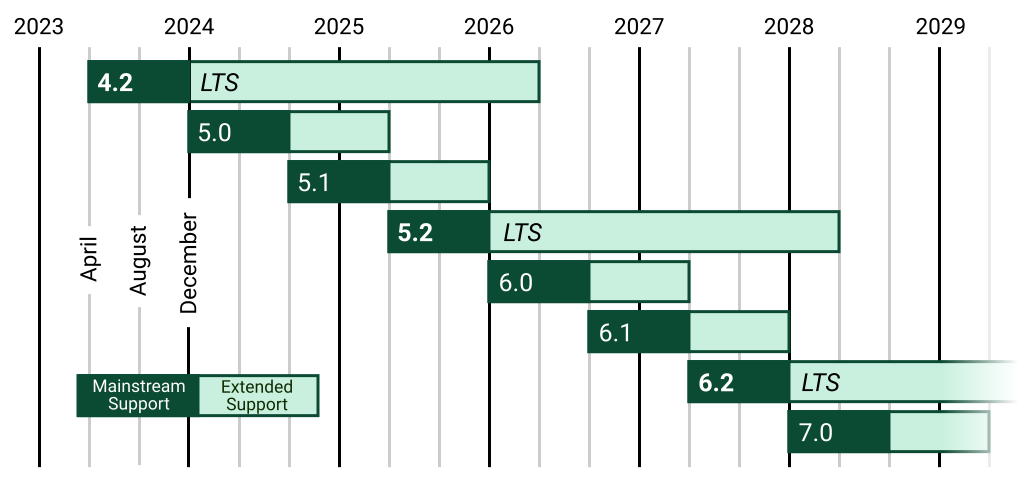
This first downloaded 4.1GB to my ~/.cache/huggingface/hub/models--Qwen--Qwen2-VL-2B-Instruct folder and then output this result, which starts:
The image is a horizontal timeline chart that represents the release dates of various software versions. The timeline is divided into years from 2023 to 2029, with each year represented by a vertical line. The chart includes a legend at the bottom, which distinguishes between different types of software versions.
Legend
Mainstream Support:
- 4.2 (2023)
- 5.0 (2024)
- 5.1 (2025)
- 5.2 (2026)
- 6.0 (2027) [...]
In the future, we won't need programmers; just people who can describe to a computer precisely what they want it to do.
OpenAI’s revenue in August more than tripled from a year ago, according to the documents, and about 350 million people — up from around 100 million in March — used its services each month as of June. […]
Roughly 10 million ChatGPT users pay the company a $20 monthly fee, according to the documents. OpenAI expects to raise that price by $2 by the end of the year, and will aggressively raise it to $44 over the next five years, the documents said.
I think individual creators or publishers tend to overestimate the value of their specific content in the grand scheme of [AI training]. […]
We pay for content when it’s valuable to people. We’re just not going to pay for content when it’s not valuable to people. I think that you’ll probably see a similar dynamic with AI, which my guess is that there are going to be certain partnerships that get made when content is really important and valuable. I’d guess that there are probably a lot of people who have a concern about the feel of it, like you’re saying. But then, when push comes to shove, if they demanded that we don’t use their content, then we just wouldn’t use their content. It’s not like that’s going to change the outcome of this stuff that much.
